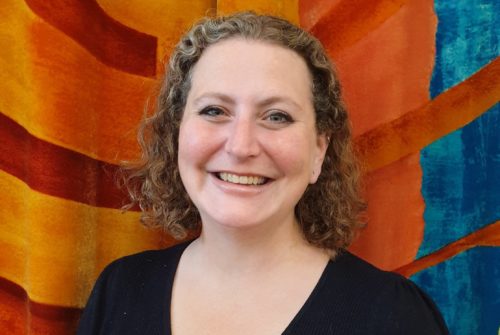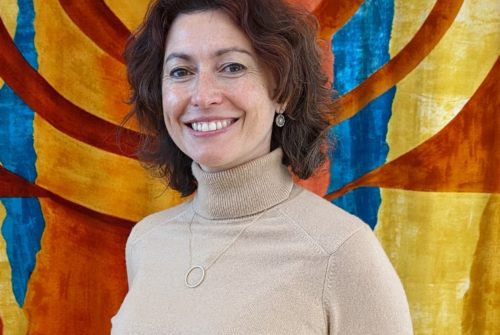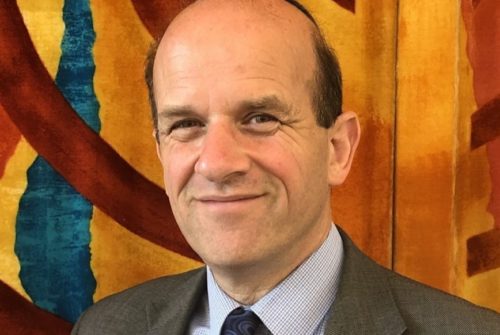My shoes still carry a little bit of the Synagogue where I preached and read Torah last week. I can’t get the sand out of the seams and actually I am happy that that memory will be with me for many weeks. I wasn’t at the beach but rather I was helping lead the service at one of the five Synagogues in the world with a sand floor. These Synagogues are in Amsterdam, Suriname a small country in Latin America, the islands of Curacao, the British Virgin Islands and Kingston, Jamaica. What links the five together is a Spanish and Portuguese origin congregation that had links to the original in Amsterdam.
I was fortunate to be in the Kingston Jamaica Shaare Shalom Synagogue last Shabbat, the day before the wedding of EHRS members Monifa Angus and Gary Lewis who brought me there. The sand on the floor is deep – deep enough that children present at the shul were playing happily in it as if it were the beach! Spare a thought for the Synagogue caretaker Rory who has to rake it flat every week before Shabbat.
An obvious question is ‘why the sand floor’. A member of the congregation, Marie Reynolds, explained that there are three theories, two spiritual and one practical. Number one – sand on the floor to remind us that we are like the original Israelites who walked across the desert to Mount Sinai, now represented by the Bimah, or Teva as they call it, which is carpeted. Number two – that God promised Abraham and Sarah that their descendants, the Jewish people would be as numerous and the grains of sand on the shore of the sea – and the forty people who were there at Shaare Shalom in Kingston on Shabbat last week were the representatives of those grains of sand. Both great reasons for having sand in your shoes on Shabbat and onwards. However theory number three may be the most likely, especially in the context of the first sand floor Synagogue in Amsterdam. Apparently when this Synagogue was built in the Mid-Seventeenth century the pavements in Amsterdam were often muddy so people would walk to shul getting their shoes in a mess. The elders of the Synagogue didn’t want the new floor of their new Synagogue ruined – so they had sand spread on the floor to stop the mess. It worked so the tradition stuck!
The sand floor is only one of the things to notice about the Kingston Jamaica Synagogue. It’s a beautiful building, looking like a mini- Bevis Marks Synagogue in style both outside and inside. In the outdoor courtyard of the Synagogue are tombstones collected some of from the thirteen Jewish cemeteries in Jamaica. Jews first came to Jamaica in 1655, though there may have been a hidden Converso population of Jews for a hundred and fifty years before. They built their first synagogue just a few years later but it was destroyed by an Earthquake in 1692. The current Shaare Shalom Synagogue was built in 1912, after its predecessor was also destroyed in an earthquake in 1907. Since 1921 it has been the only Synagogue in Jamaica, now with a membership of around 200 people. There is a recently founded Lubavich centre in Montego Bay catering mostly to tourists.
Shaare Shalom Synagogue as well as being physically beautiful is also a beautiful community. Their minhag is a Sephardi version of Reform Judaism. Men and women participate equally in leading the services, the service is always a mix of Hebrew and English, there is a Synagogue choir, and, in the tradition of the Synagogue since its foundation, a pipe organ that accompanies the services. It is open and inclusive, the congregation a mix of black and white Jamaicans. Be aware that the first black millionaire in Jamaica, George Stiebel born in 1821, was Jewish, his home Devon House and its grounds serves like a Kingston Kenwood, now open to all to visit and enjoy.
The spiritual leader of the congregation Stephen Henriques is a descendant of the original Spanish and Portuguese families who came to Jamaica in the 17th Century, and there are may other Costas, De Souzas and Lindos from those original families. But as Reform Synagogue open to and encouraging conversion for those who are often returning to the spiritual heritage of their ancestors, there are also many first generation Jews who are part of the worship and practical leadership of the congregation.
Being there for me was one of those quintessential Jewish experiences. Being part of the extraordinary resilience of Jewish communities which keep going due to the determination of their members, their generous spirits and ability to change and develop whilst also retaining their own special traditions. Anti-Semitism is not and has never been thank God an issue in Jamaica. Even in today’s toxic atmosphere round the world as anti-Zionism turns into Anti-Semitism, Jamaica has remained a safe place for Jews with virtually no anti-Zionist protest. Indeed members of the Synagogue were very concerned for us in London because of what they had picked up on social media about the depth of anti-Zionism here.
How do this outpost of Judaism keep going? Our Torah portion today tells us how. Terumah begins with very important words for anyone who believes that Judaism should continue from generation to generation, who feels that Jewish values make a contribution to the world and want to be sure that theirs is not the final generation of the Jewish community, a principle which is at the root of every Jewish community worldwide, small and large, established and new. ‘God said to Moses: Tell the Israelite people to bring me gifts, in Hebrew Terumah, from every person whose heart so moves them… Let them make Me a sanctuary that I may dwell among them.’ (Exodus 25:1-8) It doesn’t say let the Israelites depend on their previous generations to make a God worthy community. It doesn’t say tax the people so that they have no choice but to support their community life.
What it says is exactly what continues to happen in Kingston Jamaica so that there is a Jewish community to belong to, to make a contribution to the life of Jamaica, which can educate, congregate and care for each other and welcome the visitor. This generation continues to make it happen by their own generosity and willing heartedness.
And what is true for Kingston, Jamaica is true for Edgware and Hendon, England. Every generation of Jews needs to build their Jewish sanctuary. The Synagogue is the basic building block of the Jewish community. Without the Synagogue thriving the rest of the Jewish community, the schools, the charities, the care organisations will collapse within a generation. Yes we can benefit from the far sightedness of the Jews of Edgware since 1935 and of Hendon since 1949 which gives us a sanctuary to be in and benefit from, but we ourselves in our own generation must continue to build it if it is to be worthy of the name Kehillah Kadoshah, a holy community.
In Kingston it would be easy to imagine that since the community has been there since the 1650’s it will just carry on. On this campus that our Synagogue thrives upon it would be easy to imagine that EHRS doesn’t need each one us to bring our willing hearts to keep it’s life making its unique contribution to the Jewish community of London.
But it just doesn’t work like that. How many of us expect to remember EHRS in our will so that among our legacy to the world will be our own Synagogue and what it can do in the future? How many of us contribute financially to the life of our Synagogue beyond our Synagogue subscription? Obviously many of us do because many of us are the core community of EHRS. For a Synagogue community to be ambitious and not only to exist the gifts we bring from our willing hearts are critical.
Rabbi Simcha Zissel, 19th Century Musar Teacher, said that what God needs from us is not just objects of our generosity, our Terumah, but our hearts – ‘real generosity means not only giving something practical , it also means changing something in yourself. Our gifts to our community should be accompanied by joy, commitment, love – positive heartfelt qualities. (q in Everyday Holiness, Alan Morinis pp161-162) That is what we bring into the world when we give to our Synagogue – just as the people of Shaare Shalom have done and continue to do. Rabbi Simcha Zissel taught that ultimately the reward for generosity is that the giver receives the reward of God dwelling among us. When you see our community gathering together in joy, in care, in consolation, in mutual support through your generosity or legacy you see a beautiful Mishcan, built by a people among whom God’s presence dwells.



